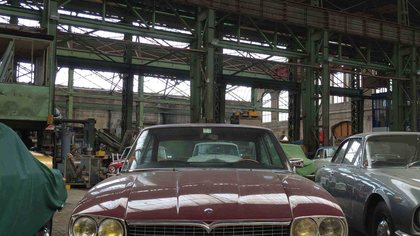Description
Restored in warm and sunny Portugal, this handsome Maserati Mexico came to the UK in 2019 and remains in excellent order throughout, having covered very few miles since then.
At the October 1965 Turin Motor Show, Vignale decided to trumpet its coachbuilding skills by presenting a bespoke handsome-looking two-door Grand Tourer coupe on its stand. The car was based on a Maserati 5000 GT that had been damaged in an accident and needed a new shell, thus giving Vignale the perfect canvas to showcase its art. Stylist Virginio Vairo, up until that point best-known for his small Fiats, was responsible for the striking quad-headlamped shape. The eye-catching GT was very well-received by those who saw it, but two of those it especially impressed had a significant effect on its destiny. The first of these was Adolfo Lopez Mateos who was the Mexican president at the time. He liked the Vignale prototype so much that he bought it and took it back home with him, thus leading to it being christened the Mexico.
And then there was Maserati itself. The reception to the Vignale convinced the Italian sports car manufacturer to build it as a commercial model – which possibly didn’t please Senor Mateos, who may have quite liked owning what was a unique machine when he bought it. As the 5000 GT had ceased manufacture in 1964, the production Mexico used the Quattroporte chassis as its basis, albeit with 11cm removed from its wheelbase. It was unveiled at the Paris Motor Show in October 1966, meaning it went from concept to showroom in just a year.
The Mexico was powered by a 4. 7-litre V8 of 290bhp, endowing it with a top speed of over 150mph. However, in 1969, a smaller 4. 2-litre V8 option was offered, giving 260bhp and a speed just shy of the 150 mark. As a premium GT, the car featured quality touches including sumptuous leather upholstery, a wooden dash, air conditioning, electric windows, iodine headlamps, servo-assisted ventilated disc brakes and Borrani chrome wire wheels (the latter only on the 4. 7-litre model; the 4. 2 made do with plain steel items). An automatic gearbox, power steering and a radio were options. Manufacture continued through to 1972; of the 480 Mexicos produced, 175 were 4. 7-litre cars and 305 were 4. 2-litre ones.
We are thrilled to offer one of the 175 more powerful variants for sale, with 4. 7-litre double overhead-camshaft V8 mated to a five-speed ZF manual transmission. It’s a rare car in its own right but even scarcer in the excellent restored condition of this one with very low mileage; the 18, 593km recorded equates to a mere 11, 553 miles.
According to its Maserati Club UK dating letter, the Mexico was manufactured in March 1970. It spent much of its life in more temperate climes on the continent but was extensively restored in Portugal last decade before export to Britain in 2019. Since then, it’s had just one registered keeper overall. Five years have done little to diminish the Portuguese renovation. The Burgundy Metallic paint still looks fresh and vibrant, and with no varying shades between panels – it’s all consistent throughout. The doors, bonnet and boot show even gaps. All the brightwork is sparkling and free from tarnishing; this includes the much sought-after centre-lock Borrani wire wheels, which look so much better than the steel items found on lesser Mexicos. The tyres have plenty of tread left, with the rubber up front being General Jet Radial complemented by Goodyear Eagle STs at the rear.
All the opulence that came as standard inside the Mexico’s cabin remains as it should. Cream is the theme, with the leather upholstery, carpeting and door cards all finished in this light shade. The generous seats are of almost armchair proportions and comfort, and look barely sat in, including the driver’s one. Complementing all this is the wooden dashboard with a deep, glossy veneer and prominent warm grain running through. It all looks very homely and inviting, and a very pleasant place to while away the hours speeding across continents. All the gauges save for the clock are functioning as they should, and the controls do their job as Maserati always intended. There’s no radio but why would you really want one, given the lovely deep V8 soundtrack that surrounds you instead. That alone should be beautiful music to any true classic car enthusiast’s ears.
Immaculate cars are often let down by an engine bay that hasn’t been detailed to quite the same level, but that’s not the case here. Everything under the bonnet is very clean and tidy, and just asking to be shown off at car events. The trident-branded air filter casing that dominates the top of the engine is finished in black paint so glossy that it could almost have been applied yesterday. It’s a mark of the attention lavished on this Maserati that even the soundproofing material under the lid is in superb order. Beneath the car, comprehensive undersealing has been carried out, with the result that there’s no corrosion. A full stainless steel exhaust has been installed too.
More of the same diamond motif soundproofing as under the bonnet lid also lines the boot and is similarly all intact and free from any significant marking. Lift the floor panels and a fifth Borrani chrome wire wheel is correctly in place in the spare well.
As a four-seater grand tourer, this Maserati isn’t as raw and raucous as some of its Italian sports car contemporaries. Instead, it’s a long-legged Grand Tourer par excellence, intended to lollop across vast distances without it – or any of its occupants – breaking into a sweat. With close to 300bhp on tap, it certainly give a very good account of itself on fast roads but the huge reserves of torque plus the well-weighted steering and sharp brakes also make it just as satisfying around town. The V8 runs with the sublime smoothness you’d expect of a perfectly tuned Italian thoroughbred machine and there’s no hesitation or missing once underway. That’s reassuring given that the four Weber twin-choke carburettors can require specialist tuning if out of sorts. But here, there’s no need for an expensive expert. The five-speed manual gearbox is also easy to use although, as with any prestige sports car of this era, it is smoother and slicker once its oil is at the optimum operating temperature.
Paperwork accompanying the Maserati includes the V5C showing just one registered keeper since the vehicle arrived in Britain, along with the dating letter from the Maserati Club UK, period Maserati range brochure, some photos of the restoration work (including what looks like a gearbox rebuild) and invoices including an April 2023 service and carburettor work at a cost of £868. 80. The odometer reading recorded was 18, 437km so since then, it’s covered less than 100 miles.
This 4. 7-litre Mexico is an uncommon find, as one of just 175 made. Following its Portuguese restoration, it has seen very little British use and has all the correct credentials to justify its place in even the most illustrious of classic collections. With all the hard graft already done, the real challenges will be to keep it looking as good as it does and choosing just how many enjoyable miles to add to the comparatively few already covered during its 55-year life. Please call for full details; we love talking Italian cars.
While Greenside Cars Ltd has tried to ensure information and assessments are accurate and complete, we are aware that some errors and omissions may occur from time to time. We are not able, therefore, to guarantee the accuracy of information and cannot accept liability for loss or damage arising from it. We highly recommend that you examine any vehicle to check the reliability of the information supplied. Please contact us for further details, images, or to arrange a viewing of this 1970 Maserati Mexico.

















